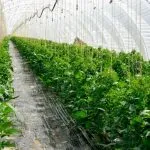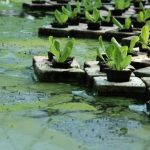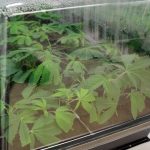Managing the temperature in your grow tent is an essential aspect of creating a perfect environment for your plants to flourish. Proper temperature control not only affects the overall health of your plants but also plays a critical role in maximizing their growth, nutrient uptake, and yield.
In this comprehensive guide, we will delve into the importance of maintaining optimal temperatures within your grow tent and share practical strategies on how to keep the temperature down in a grow tent for your hydroponic setup.
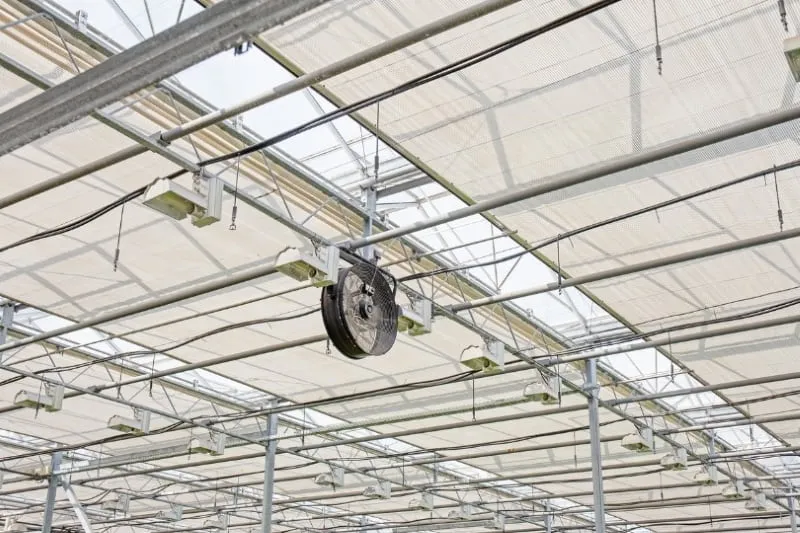
From understanding ideal temperature ranges during various stages of plant growth to exploring effective cooling techniques such as ventilation systems, insulation methods, and shading solutions – we’ve got you covered! So stay with us as we take you through all the crucial aspects of keeping your hydroponic haven cool and thriving throughout the year.
- Importance of Temperature Control in Your Grow Tent
- Negative Effects of High Temperatures on Plant Growth
- Setting Up Proper Ventilation
- Utilizing Cooling Systems
- Effective Use of Shades or Reflective Materials
- Considerations When Selecting Lighting Systems
- Water Management Strategies
- Troubleshooting High Temperatures
- FAQs
Importance of Temperature Control in Your Grow Tent
Proper temperature regulation plays a critical role in the success of a hydroponic garden. Learning how to control temperature in a grow tent is essential for maintaining optimal growing conditions that promote vigorous plant growth, health, and productivity.
Temperature control significantly affects various aspects of your plants’ development like nutrient uptake, photosynthesis rate, respiration, and pest and disease resistance. We have more details about aiming for the ideal temperature for hydroponics.
Related: Having the opposite problem of a too-hot environment? Here’s how to raise heat in a grow tent.
Negative Effects of High Temperatures on Plant Growth
High temperatures can significantly impact plant growth in a hydroponic system, leading to various negative effects that may hinder overall productivity. Some of these consequences include:
- Reduced Photosynthesis: Elevated temperatures can reduce the rate of photosynthesis, as the enzymes responsible for this process function optimally within specific temperature ranges. As a result, plants may struggle to produce enough energy for their growth requirements.
- Decreased Nutrient Uptake: High temperatures can lead to a decrease in dissolved oxygen levels in the nutrient solution, making it more challenging for plants to absorb essential nutrients. This can result in nutrient deficiencies and hinder overall plant health.
- Increased Water Loss: Elevated temperatures increase water evaporation rates from both the nutrient solution and plant transpiration, leading to dehydration and possible wilting if not adequately addressed.
- Stress Response: Prolonged exposure to high temperatures can trigger stress responses in plants, which can manifest as stunted growth or even death in severe cases.
- Greater Susceptibility to Diseases and Pests: Stressed plants become more vulnerable to diseases and pests such as mold, mildew, and various insects. These issues could further compromise your hydroponic system’s overall yield and quality.
To ensure optimal plant growth and avoid these negative effects associated with excessive heat within your grow tent, it is crucial to implement temperature control strategies that maintain ideal conditions for your hydroponic garden.
Setting Up Proper Ventilation
To know how to keep the temperature down in a grow tent, you should first prevent the accumulation of hot air in it, then use appropriate methods to further cool it down.
The Role of Ventilation in Controlling Temperature
Ventilation plays a crucial role in maintaining an optimal temperature within a grow tent for hydroponic systems. By providing continuous air exchange, it helps to dissipate heat generated by the grow lights and other equipment, keeping the environment cool and preventing overheating. Furthermore, proper ventilation ensures that fresh carbon dioxide (CO₂) is supplied to plants, which aids in photosynthesis and overall plant growth.
Choosing the Right Fan Size and Placement for Efficient Airflow
To set up proper ventilation in your grow tent, you need to select the right fan size and placement. The right fan size depends on your grow tent’s volume. A general rule of thumb is to choose a fan capable of replacing the entire volume of air within your grow tent at least once per minute. To calculate the correct cubic feet per minute (CFM) rating, multiply the length × width × height of your grow tent.
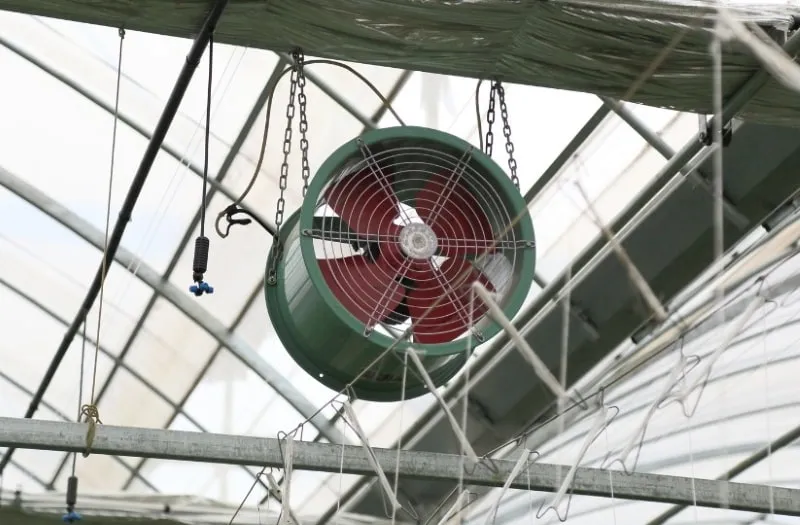
Once you’ve determined the appropriate fan size, it’s essential to place it correctly within your grow tent for maximum efficiency. Ideally, exhaust fans should be situated near or at the top of the grow tent since warm air rises – this will help in removing hot air more effectively. Additionally, try positioning oscillating fans below plant canopies to provide uniform airflow and maintain stable temperatures throughout.
Importance of Inlet and Outlet Vents
Inlet and outlet vents are vital components of any effective ventilation system. These vents are responsible for bringing fresh air into your grow space while expelling stale, warm air outside.
Inlet vents are usually placed near or at the bottom of your grow tent to draw in cooler air from outside – this helps regulate temperatures inside while ensuring an adequate supply of CO₂ for plants.
Outlet vents work hand-in-hand with exhaust fans as they allow hot air to exit from the top section of your grow space – keeping temperatures down and making room for fresh, cool air.
Utilizing Cooling Systems
In order to maintain an optimal environment for your hydroponic plants, it’s crucial to keep the temperature down in your grow tent. Now let’s discuss the types of cooling systems available, their respective pros and cons, and how to properly install and maintain them.
Types of Cooling Systems
There are two main types of cooling systems that can be used for a hydroponic grow tent:
- Air Conditioners: These devices work by transferring heat from the indoor air to the outdoor environment. They come in various sizes and capacities, suitable for different sizes of grow tents.
- Pros: Effective at cooling; precise temperature control; dehumidification capabilities
- Cons: Expensive upfront cost; higher energy consumption; requires proper ventilation setup
- Evaporative Coolers: Also known as swamp coolers, these devices use water evaporation to cool the air inside the grow tent. They tend to be more energy-efficient than air conditioners but may not work as effectively in highly humid environments.
- Pros: Energy-efficient; lower operating costs; adds moisture to dry environments
- Cons: Less effective in high humidity settings; requires a consistent water supply; susceptible to mold growth if not cleaned regularly
How to Properly Install and Maintain Cooling Systems
- For air conditioners, ensure that you choose a unit with the appropriate BTU capacity for your grow tent’s size. Place it near an exhaust fan or vent for optimal airflow and follow manufacturer instructions for installation. Regularly clean or replace the filters to maintain efficiency, check for refrigerant leaks, and ensure that all components are functioning properly.
- For evaporative coolers, position them close to an air intake vent or fan for maximum effectiveness and water supply access. Clean the water tray regularly to prevent mold and algae growth, replace cooling pads as needed, and inspect the system for any leaks or malfunctions.
By understanding your options and following proper installation and maintenance guidelines, you can effectively utilize cooling systems and know how to keep heat down in your grow tent.
Effective Use of Shades or Reflective Materials
Growing plants using hydroponics often require maintaining the ideal temperature inside the grow tent to ensure optimal growth and health. One way to keep the temperature down is by effectively using shades or reflective materials. This helps in managing heat absorption from external sources and providing the appropriate shade density for various plant types.
Using Shade Cloth or Reflective Materials to Reduce Heat Absorption from External Sources
Shade cloth or reflective materials such as Mylar are essential tools in controlling heat absorption within a grow tent. By placing these materials on the exterior or interior of the tent, they reflect sunlight and reduce heat transfer from external sources. This helps maintain a cooler environment inside the grow tent, preventing excessive temperature fluctuations that may negatively impact plant growth.
Additionally, these materials can block harmful UV rays that may cause damage to delicate plants. Moreover, they help in evenly distributing light across all plants, thus promoting uniform growth.
Choosing the Appropriate Shade Density for Different Plant Types
Different plants have different light and temperature requirements for optimal growth. When selecting a shade cloth or reflective material, it’s essential to consider your plants’ specific needs.
Shade cloths come in varying densities, typically ranging from 30% to 90%. A higher percentage indicates more shade provided by blocking out a larger portion of sunlight. For example, if you’re growing plants that thrive in partial shade like lettuce, opt for a shade cloth with 50-60% density. On the other hand, sun-loving plants such as tomatoes might require lighter shading with only 30-40% density.
To determine the perfect balance between adequate light exposure and reduced heat absorption, you must consider each plant’s preferences along with local climate conditions. By choosing an appropriate shade density and strategically placing reflective materials within your grow tent, you’ll be able to maintain lower temperatures while ensuring healthy plant growth throughout your hydroponic garden.
Considerations When Selecting Lighting Systems
Impact of Lighting Systems on Temperature Management
When setting up a grow tent for hydroponics, it’s crucial to consider the impact of lighting systems on temperature management. Various types of lights generate different amounts of heat, and this can greatly influence the internal climate within your grow tent. Excess heat can lead to unfavorable growing conditions, potentially harming your plants and reducing yields.
To effectively manage temperature levels in your grow tent, it’s essential to carefully select a lighting system that meets the needs of your plants while minimizing heat generation.
Energy-Efficient Lighting Options That Emit Less Heat
Selecting energy-efficient lighting options is an excellent way to reduce heat emission within your hydroponic grow tent. Here are some popular energy-saving options:
- LED (Light Emitting Diode) Lights: LED lights are widely recognized as one of the most energy-efficient choices for hydroponic growers. They emit less heat compared to other popular systems like High-Pressure Sodium (HPS) lamps and Metal Halide (MH) bulbs. Additionally, LEDs offer a broad spectrum of light that can be tailored to meet specific plant requirements, further optimizing growth conditions.
- CFL (Compact Fluorescent Light) Bulbs: CFL bulbs are another energy-efficient option that emits relatively low heat levels compared to traditional HID (High-Intensity Discharge) lighting systems. These lights are suitable for smaller grow tents or when used in combination with other light sources.
- Ceramic Metal Halide (CMH) Lights: CMH lights combine the efficiency of metal halide lamps with the lower heat output associated with ceramic technology. Though not as energy-efficient as LEDs, they still produce significantly less heat than standard MH and HPS lamps.
Implementing Light Cycles and Timing
To effectively manage the temperature inside a grow tent for hydroponics, it’s essential to implement proper light cycles and timing. Adjusting light cycles can significantly reduce heat generation during the hottest part of the day.
Optimizing Light Schedules
By running your grow lights during cooler periods, such as early morning or late evening, you can avoid excessive heat buildup during peak temperatures. It’s best to choose a 12-18 hour light schedule, depending on your plants’ specific needs.
Nighttime Cooling Advantage
Turning off your grow lights at night allows for natural cooling and maintains a more stable temperature in your tent. As nights are generally cooler than days, this helps minimize heat stress on your plants and keeps them thriving.
Using Timers for Effective Control
Utilize timers to ensure consistency in your adjusted light cycles. By automating this process, you can reliably maintain an optimal environment for plant growth while minimizing heat generation throughout the day.
Water Management Strategies
Managing Water Temperature Within the Optimal Range
To ensure the health and productivity of your hydroponic plants, it is crucial to maintain water temperature within the optimal range of 68°F to 72°F (20°C to 22°C). Maintaining this temperature range promotes proper nutrient uptake, oxygen levels, and overall plant growth. You can achieve this by using a submersible water heater or cooler system that actively monitors and adjusts water temperatures. Also, consider insulating your reservoir or using a light reflective cover to minimize fluctuations caused by external heat sources.
Preventing Excess Heat Buildup Through Proper Water Circulation
Proper water circulation plays a significant role in preventing excess heat buildup within your hydroponic grow tent. By continuously circulating the nutrient solution throughout your system, you help disperse heat evenly while promoting an ideal growing environment for your plants. Implementing tools such as air stones, pumps, and circulation fans encourages efficient water movement and prevents hot spots from forming in your reservoir.
Additionally, using evaporative cooling techniques like adding a small fan near the surface of the water can further decrease unwanted heat accumulation and ensure consistent temperatures throughout your grow tent.
Troubleshooting High Temperatures
It’s finally time to discuss the process of troubleshooting high temperatures in a grow tent specifically designed for hydroponics systems. By identifying common causes and providing helpful tips and solutions, you can efficiently maintain an optimal grow tent cooling system for successful plant growth.
Identifying Common Causes of High Temperatures in Grow Tents
High temperatures in a grow tent can be caused by several factors, which include:
- Poor Ventilation: Insufficient airflow within the grow tent may result in heat buildup, leading to a rise in temperature. Ensure that your exhaust fan is functioning correctly and adequate air exchange is taking place. Adding extra oscillating fans within the tent can help distribute air evenly and remove excess heat from the space.
- Excessive Lighting: Overly powerful or improperly placed lights can generate excessive heat around the plants. Reevaluate your lighting setup by considering less heat-producing light sources such as LED or fluorescent lights, adjusting their height to avoid close proximity to plants, or implementing a proper light schedule to minimize excessive heating during peak hours.
- External Heat Sources: Nearby appliances or other heat-emitting equipment can affect the overall temperature inside your grow tent. Make sure that external factors are well managed by relocating these appliances or equipment.
- Incorrect Thermostat Settings: Incorrect calibration or malfunctioning temperature control systems may cause undesired temperature fluctuations. Regularly check thermostat settings to ensure accurate readings and proper functionality of cooling systems.


